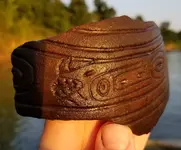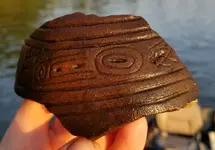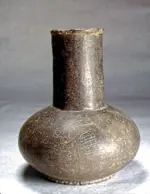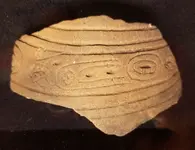DownNDirty
Bronze Member
- Joined
- Jun 1, 2015
- Messages
- 2,178
- Reaction score
- 3,207
- Golden Thread
- 1
- Location
- South Carolina
- 🥇 Banner finds
- 1
- 🏆 Honorable Mentions:
- 1
- Detector(s) used
- Minelab Equinox 800
- Primary Interest:
- All Treasure Hunting
Over the past five years I have spent hundreds of hours hunting the sandbars of a local river for Native American pottery, and have found literally thousands of sherds. Many of them have elaborate decorative marks and designs of a wide variety. Recently I was wading one sandbar about chest deep when I spotted a good-sized sherd on the bottom and picked it up.


I immediately knew that this was unlike any pottery sherd I have ever found and that it was something really special. There is an incised band that would have circled around the vessel, with a repeating motif. A little bit of research and a conversation with an archaeologist confirmed that this was part of a water vessel like the one pictured below

The motif is from the Southeastern Ceremonial Complex (SECC), which was a Native American culture during the Mississippian Period. Their religious beliefs revolved around the Beneath World, Middle World and Above World, and supernatural creatures that inhabited them. Imagery like the motif on my pottery piece is extremely rare for South Carolina and is most often found in Mississippi, Arkansas and Tennessee.

Adam King, an archaeologist with the University of South Carolina who is their expert on Mississippian culture did a hands-on ID of the sherd. He sent me these comments in an email:
"That is unique! I’ve rarely seen imagery like that on a pot. I think it is a water creature, maybe a snake or underwater panther. It is comparable in some ways to what is depicted on the rattlesnake gorgets—similar body motifs, squared teeth, and “forked eye surround” with squared ends and dots. Compare it to the Lick Creek and Brakebill styles.
First, in the beliefs of people of the Southeast, the underwater panther or piasa (cat monster) is an avatar for the Great Serpent. Both are thought of as lord of the beneath (under water) world. I think that is what is being depicted and it may be a snake, but it may have some cat monster aspects.
Your sherd shares some themes and motifs with the rattlesnake gorget sequence centered in eastern Tennessee. A few rattlesnake gorgets have been found here in SC, so I could see the gorgets influencing local pottery. As you've implied (possible shell tempering) this might not be a local sherd. The rattlesnake gorgets all share some key features, including the squared teeth, forked eye surround with square ends, and bodies decorated with concentric circles, swirls, and spinning crosses. The things I've called whiskers I think are shared both by the gorgets and your sherd, too. On your sherd they come off the nose, while on the gorgets they appear as part of the decoration of the snout. I think that is a stylistic choice and that they both represent the same thing. The whiskers are what make me think of the cat monster.
Two things are interesting about the sherd. While the creature has a linear body (and could be a snake) it lacks the cross-hatched body decoration that seems to indicate a snake across different Mississippian stylistic traditions. It does have the barred oval (which is a variation on the concentric circle and ogee, as you indicated), and that idea appears on the snake bodies. It does appear on other critters, too. The other thing is that the "forked eye" appears as a motif on the creature's body on your sherd, but is a surround decorating the eye of the snakes. That makes me thing your sherd has thematic associations with those snakes, but isn't the same thing. If it was the same snake, it would have that surround on the eye.
The forked eye does appear in other imagery as a motif by itself. I've included images of a bottle found in eastern Tennessee that has some of the same motifs as the rattlesnake gorgets and was likely executed in the same style as the Citico style gorgets.
Overall, I'd say your sherd is intended to depict a Beneath World creature that has the ability to travel between realms. Pretty cool!"


I immediately knew that this was unlike any pottery sherd I have ever found and that it was something really special. There is an incised band that would have circled around the vessel, with a repeating motif. A little bit of research and a conversation with an archaeologist confirmed that this was part of a water vessel like the one pictured below

The motif is from the Southeastern Ceremonial Complex (SECC), which was a Native American culture during the Mississippian Period. Their religious beliefs revolved around the Beneath World, Middle World and Above World, and supernatural creatures that inhabited them. Imagery like the motif on my pottery piece is extremely rare for South Carolina and is most often found in Mississippi, Arkansas and Tennessee.

Adam King, an archaeologist with the University of South Carolina who is their expert on Mississippian culture did a hands-on ID of the sherd. He sent me these comments in an email:
"That is unique! I’ve rarely seen imagery like that on a pot. I think it is a water creature, maybe a snake or underwater panther. It is comparable in some ways to what is depicted on the rattlesnake gorgets—similar body motifs, squared teeth, and “forked eye surround” with squared ends and dots. Compare it to the Lick Creek and Brakebill styles.
First, in the beliefs of people of the Southeast, the underwater panther or piasa (cat monster) is an avatar for the Great Serpent. Both are thought of as lord of the beneath (under water) world. I think that is what is being depicted and it may be a snake, but it may have some cat monster aspects.
Your sherd shares some themes and motifs with the rattlesnake gorget sequence centered in eastern Tennessee. A few rattlesnake gorgets have been found here in SC, so I could see the gorgets influencing local pottery. As you've implied (possible shell tempering) this might not be a local sherd. The rattlesnake gorgets all share some key features, including the squared teeth, forked eye surround with square ends, and bodies decorated with concentric circles, swirls, and spinning crosses. The things I've called whiskers I think are shared both by the gorgets and your sherd, too. On your sherd they come off the nose, while on the gorgets they appear as part of the decoration of the snout. I think that is a stylistic choice and that they both represent the same thing. The whiskers are what make me think of the cat monster.
Two things are interesting about the sherd. While the creature has a linear body (and could be a snake) it lacks the cross-hatched body decoration that seems to indicate a snake across different Mississippian stylistic traditions. It does have the barred oval (which is a variation on the concentric circle and ogee, as you indicated), and that idea appears on the snake bodies. It does appear on other critters, too. The other thing is that the "forked eye" appears as a motif on the creature's body on your sherd, but is a surround decorating the eye of the snakes. That makes me thing your sherd has thematic associations with those snakes, but isn't the same thing. If it was the same snake, it would have that surround on the eye.
The forked eye does appear in other imagery as a motif by itself. I've included images of a bottle found in eastern Tennessee that has some of the same motifs as the rattlesnake gorgets and was likely executed in the same style as the Citico style gorgets.
Overall, I'd say your sherd is intended to depict a Beneath World creature that has the ability to travel between realms. Pretty cool!"
Upvote
28





